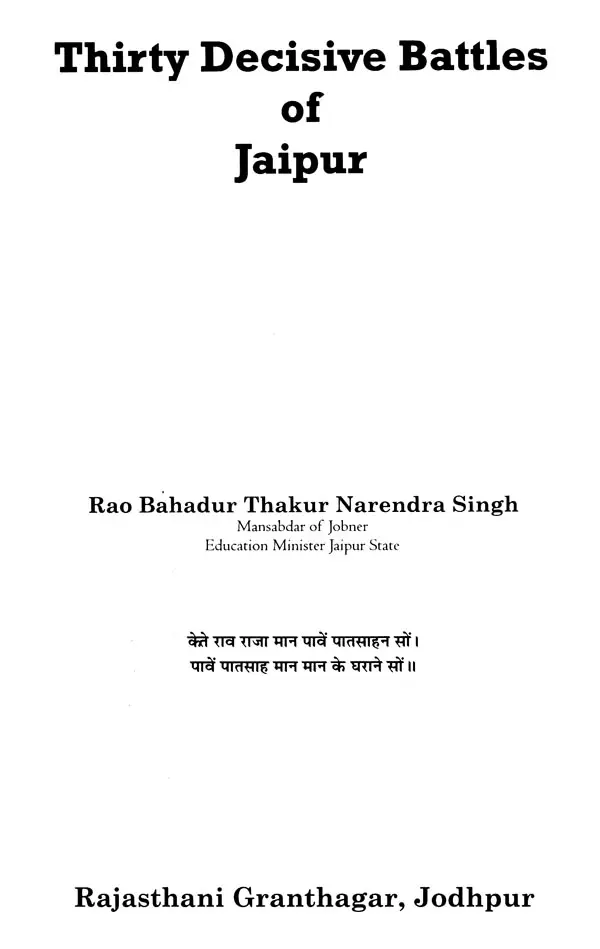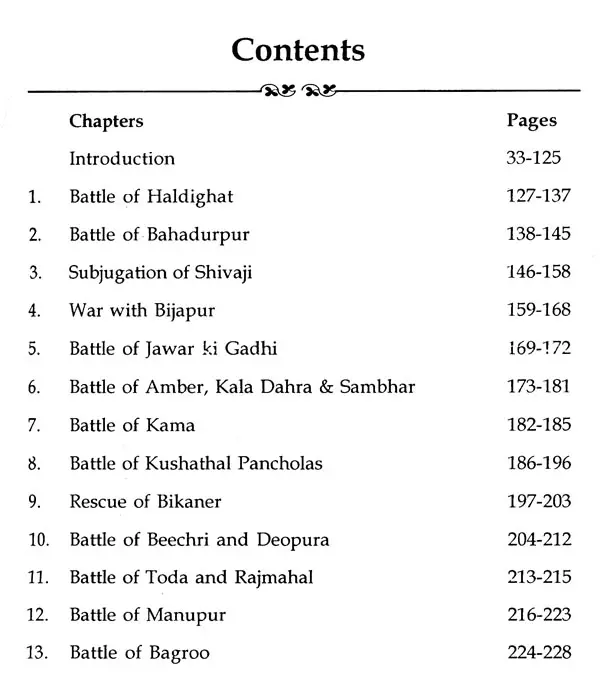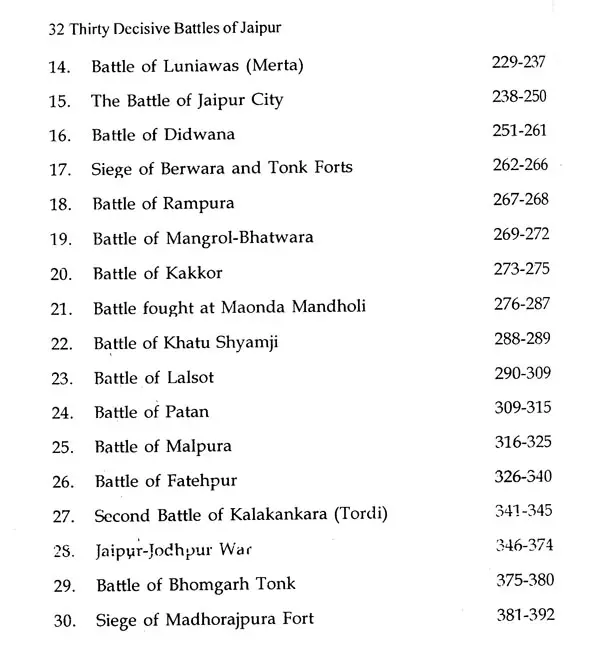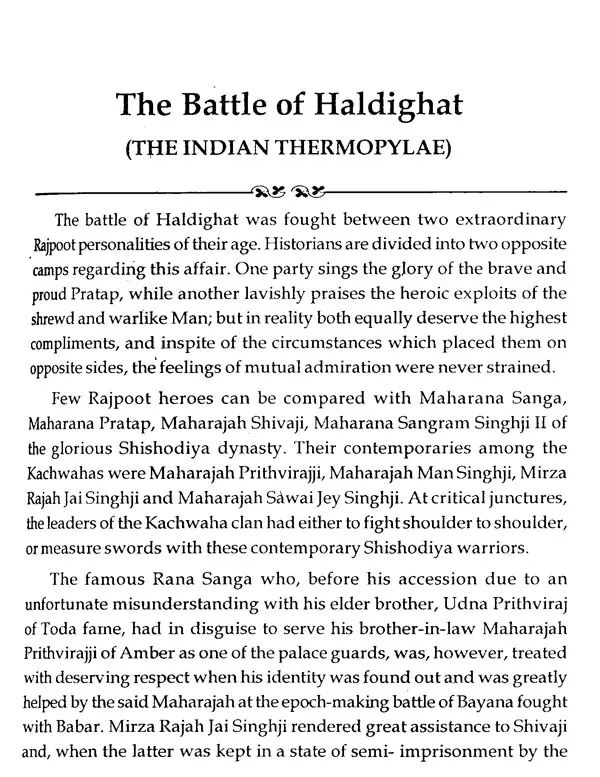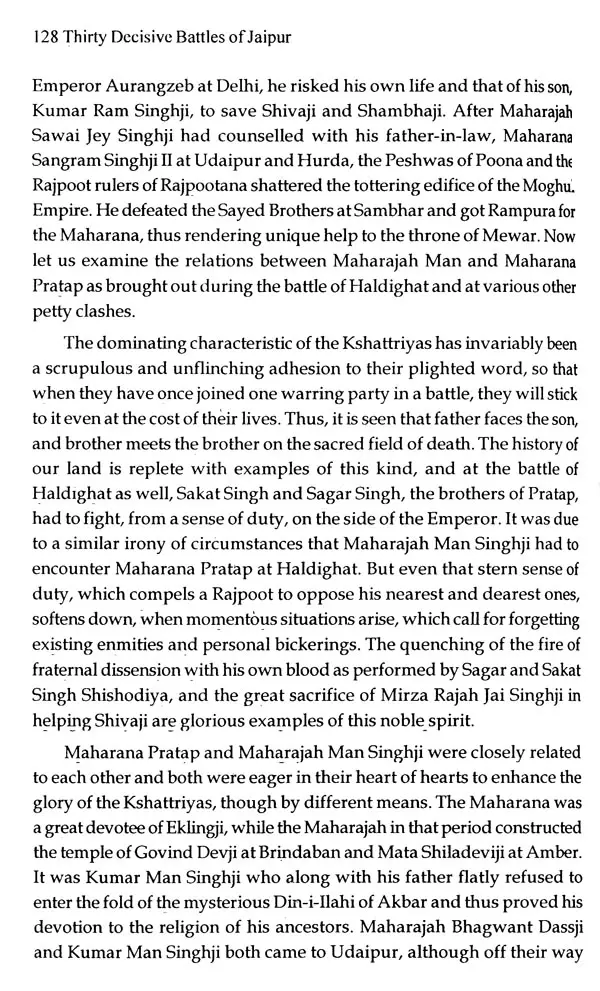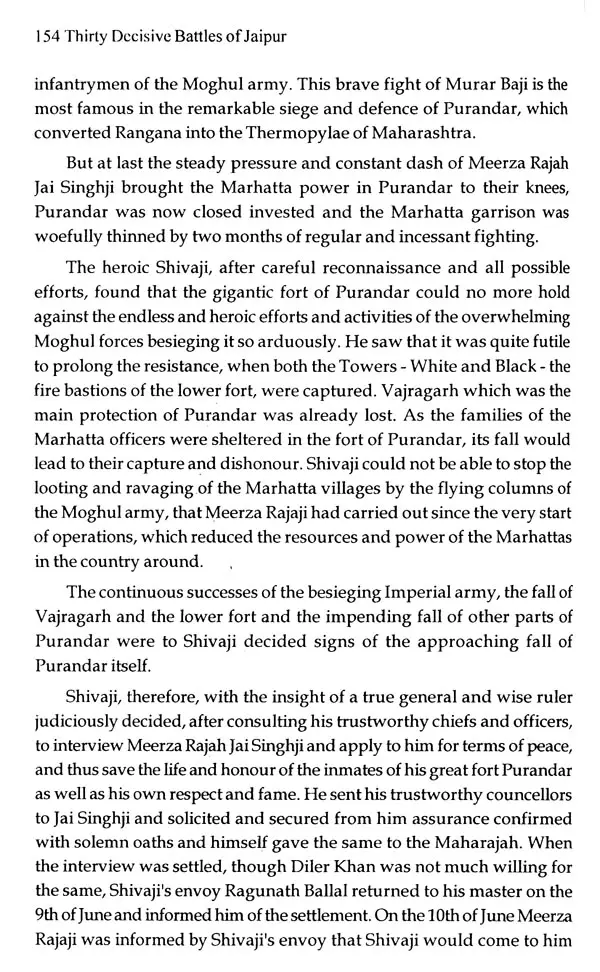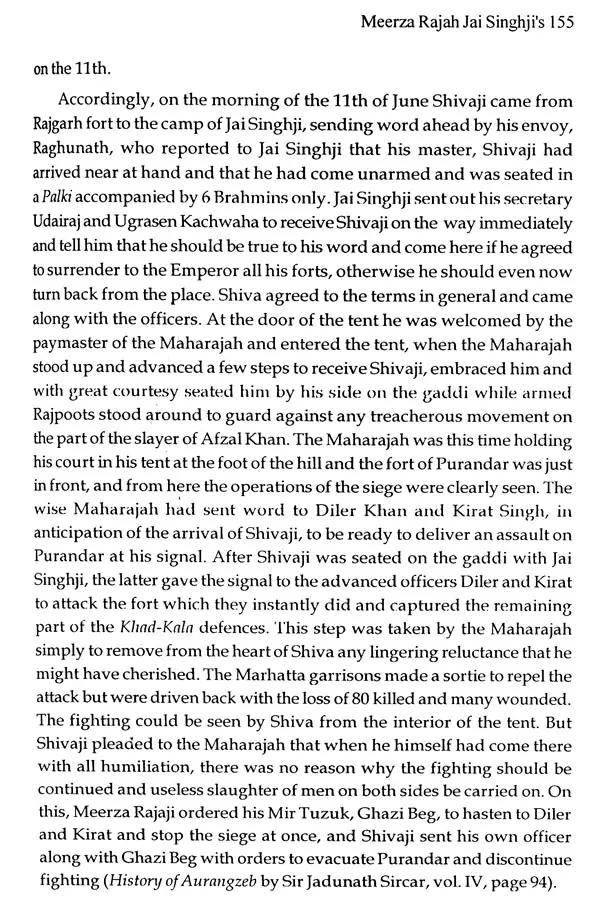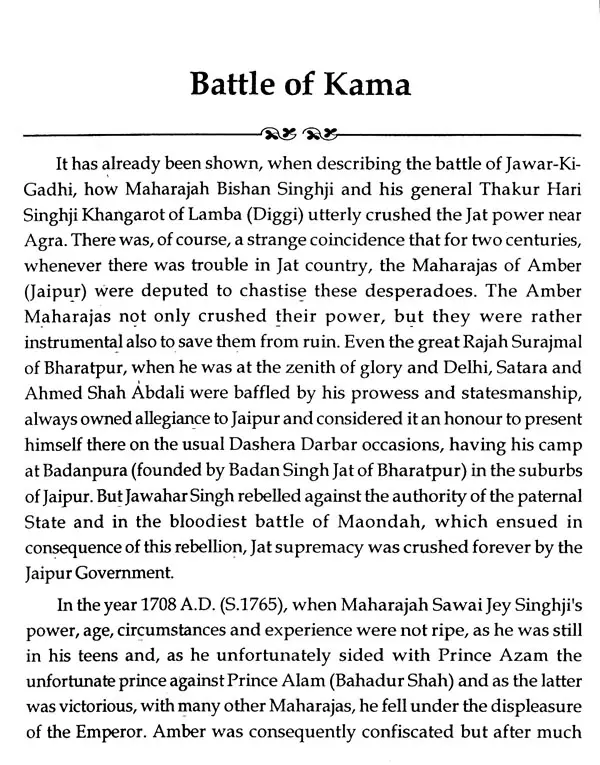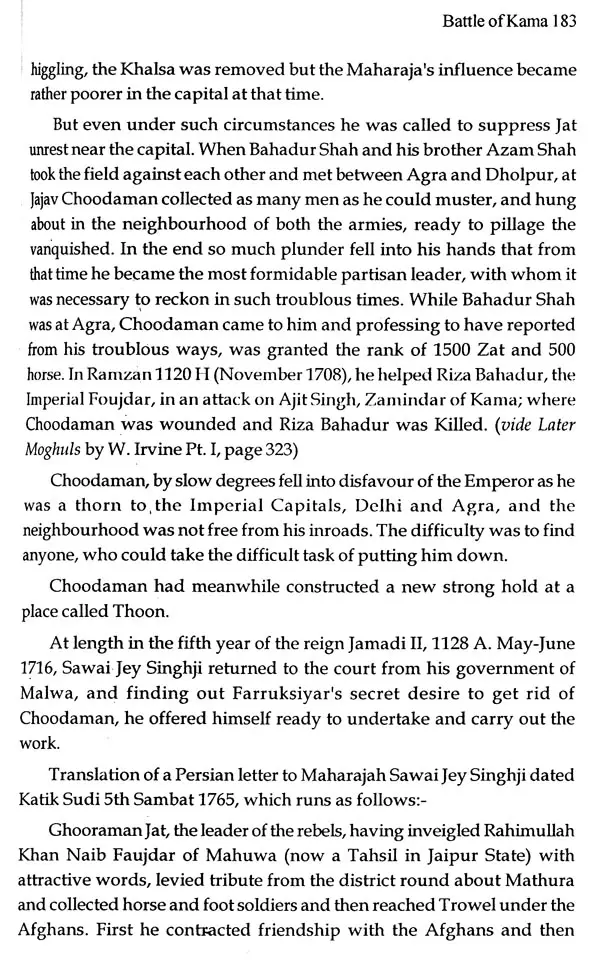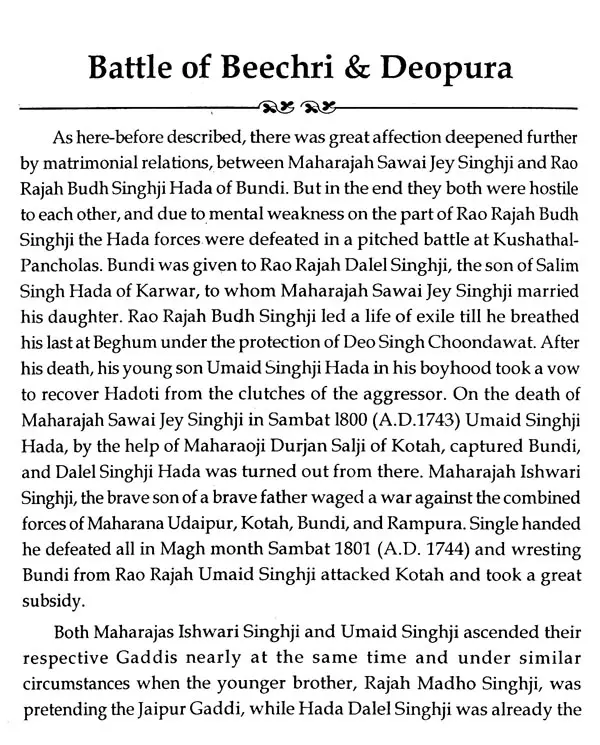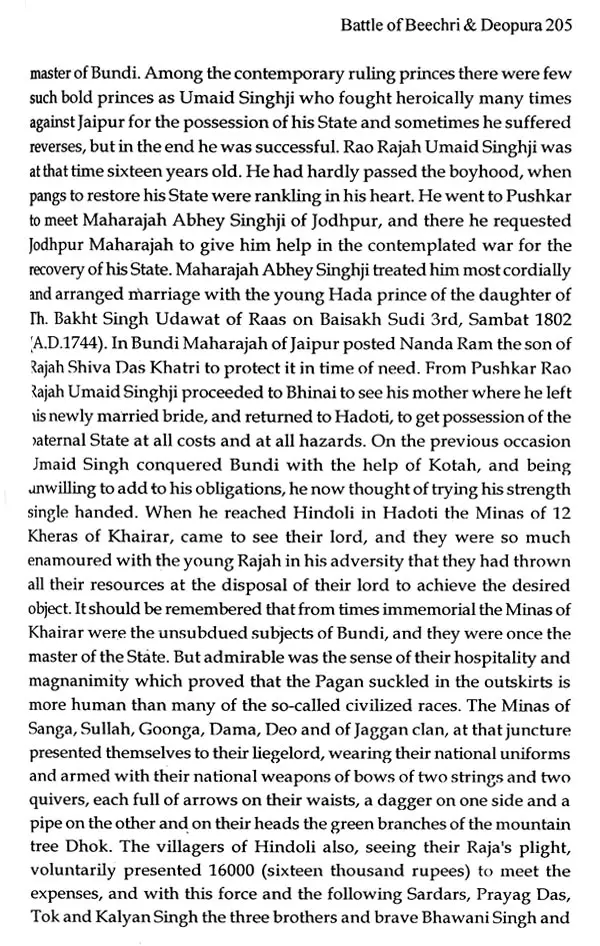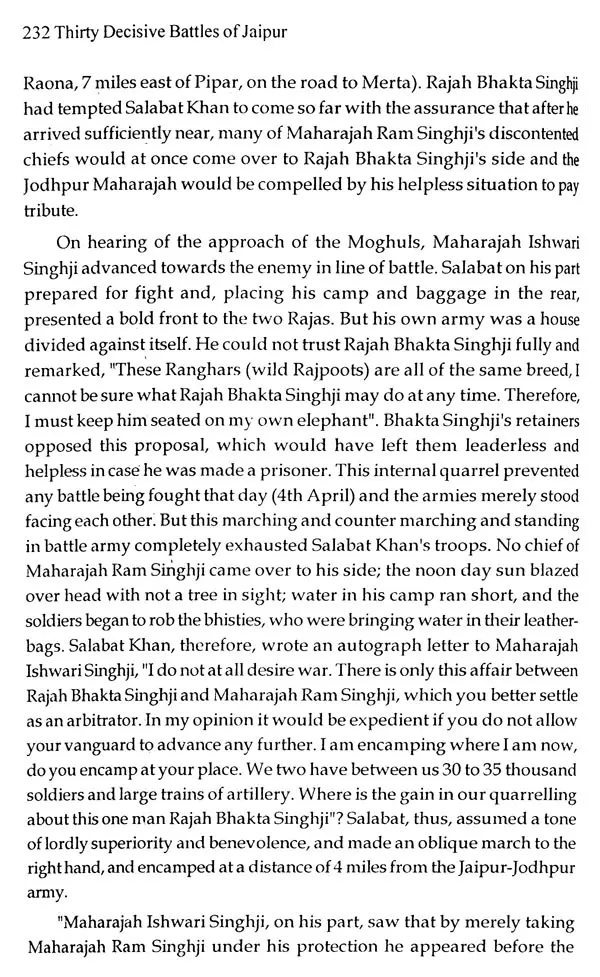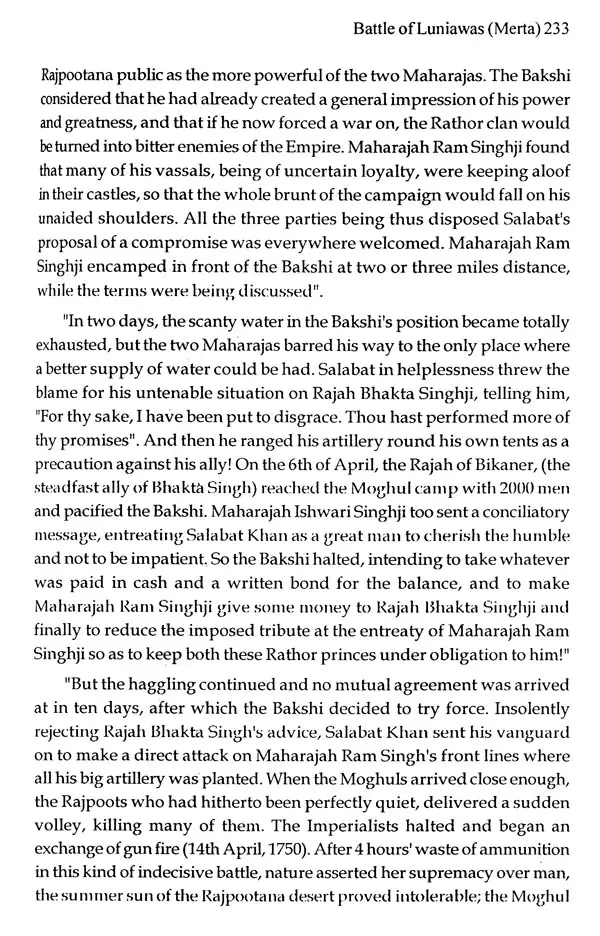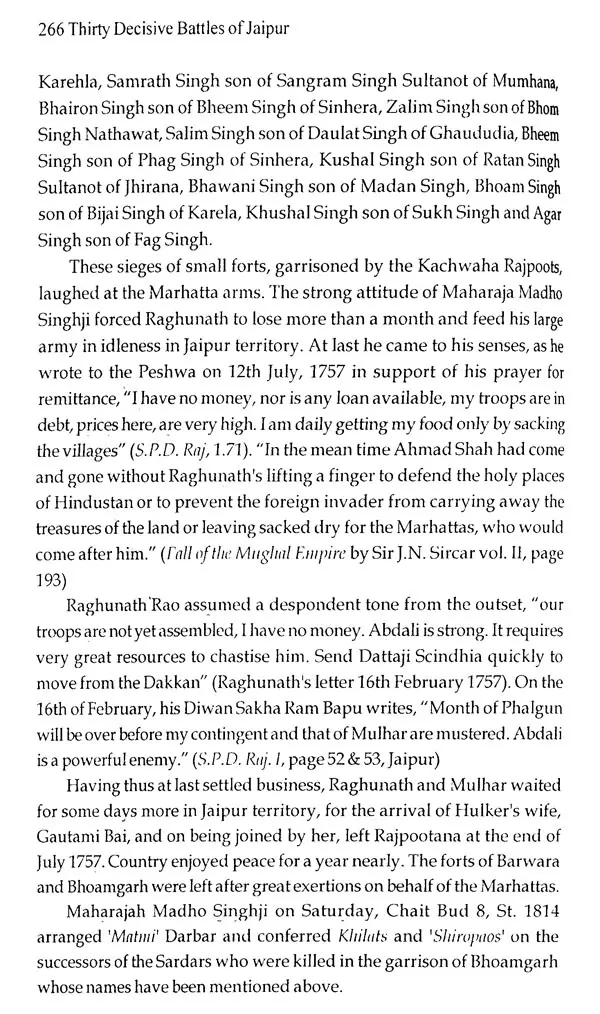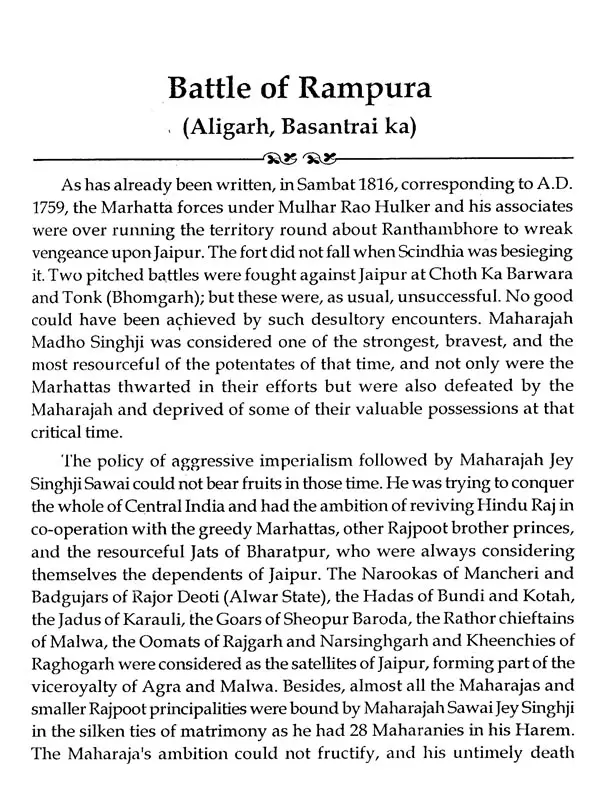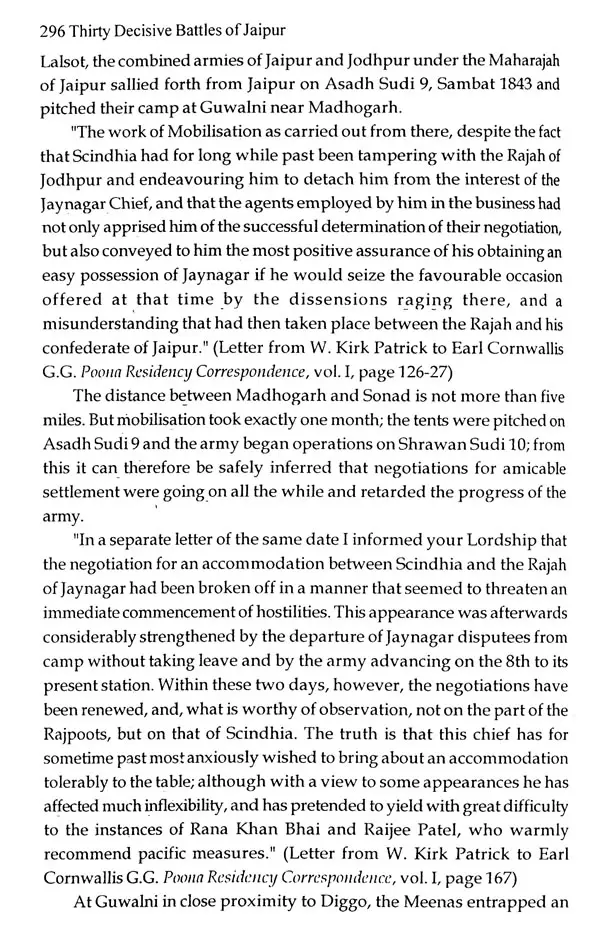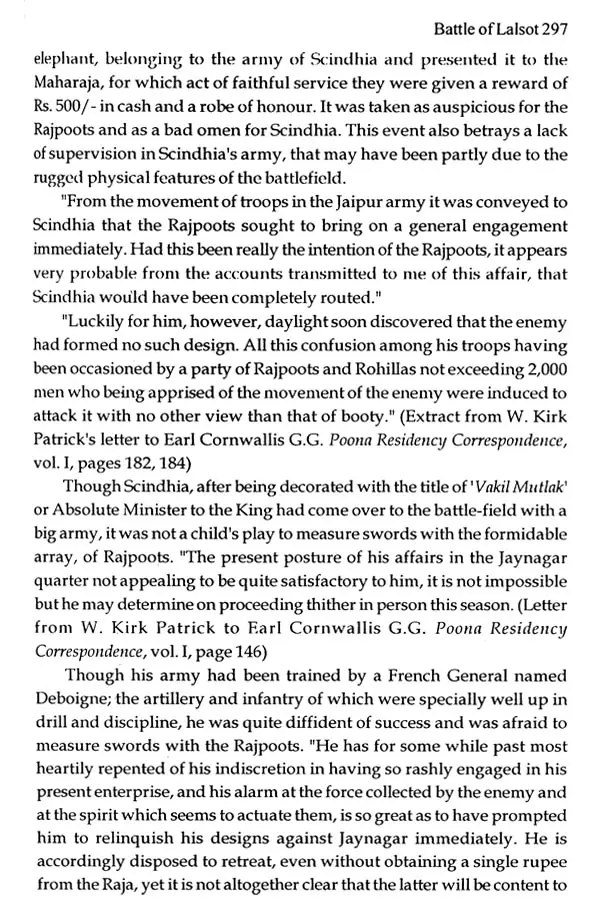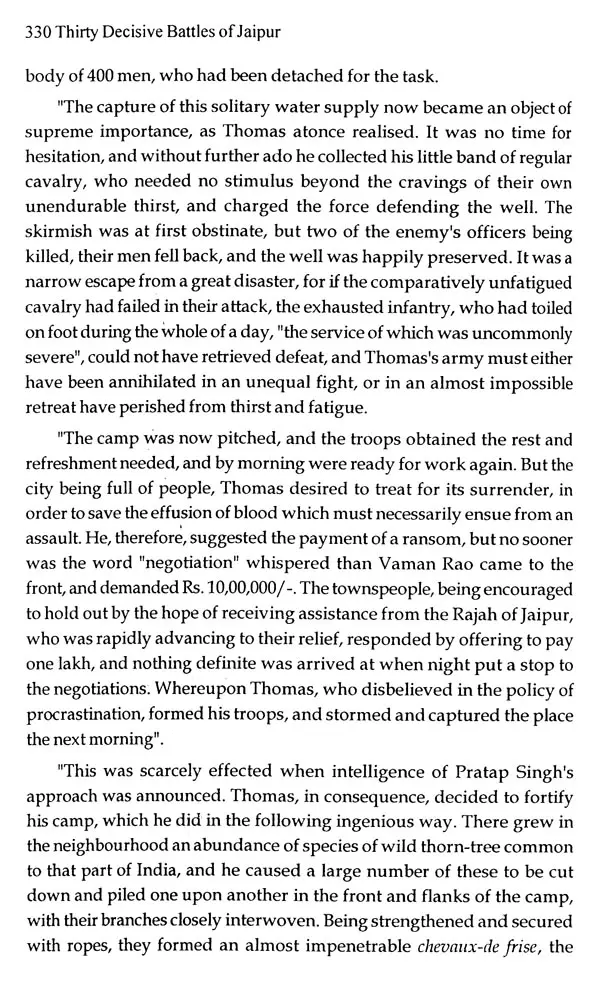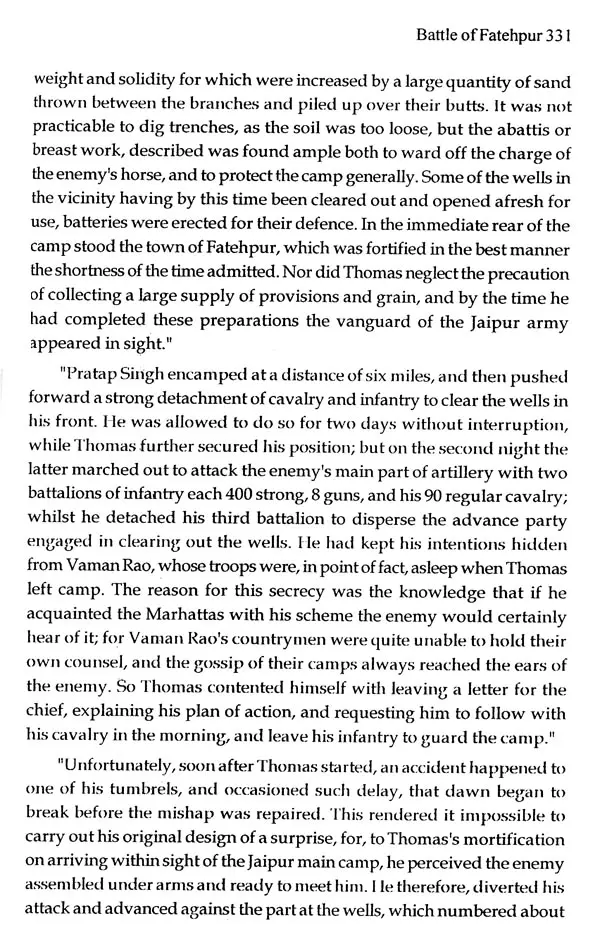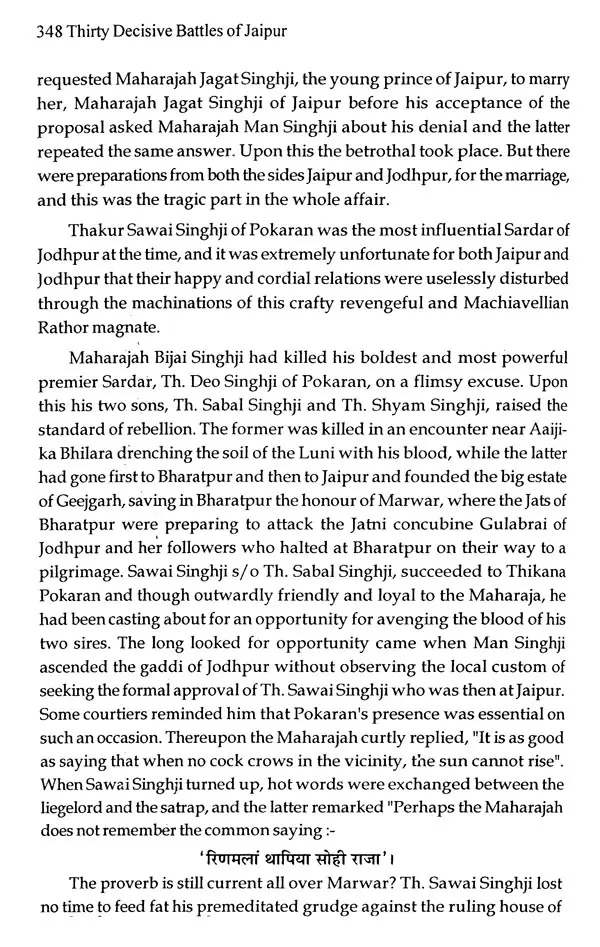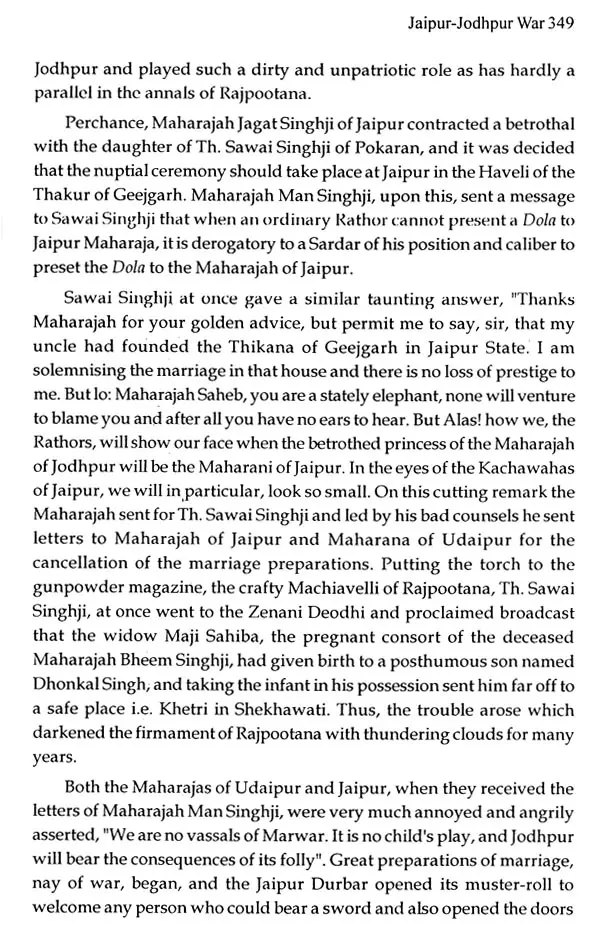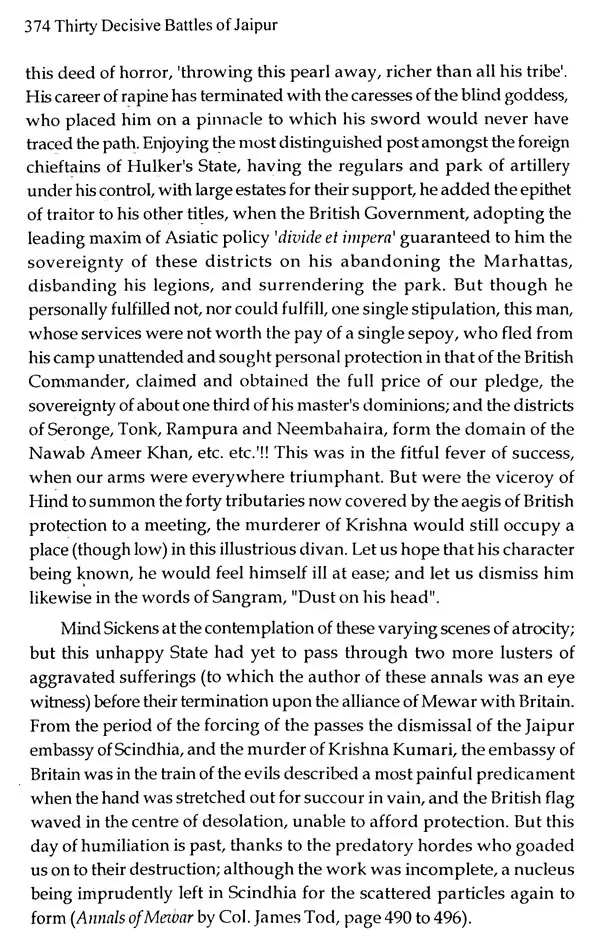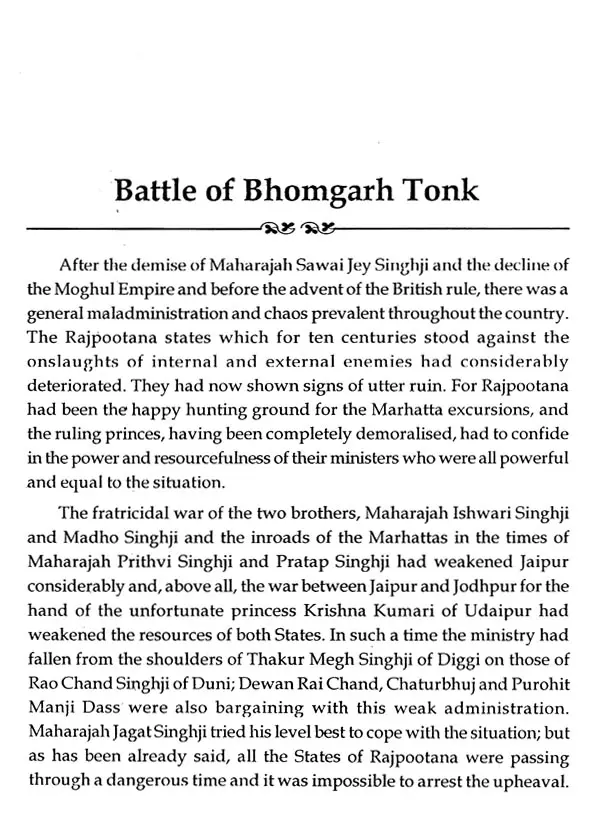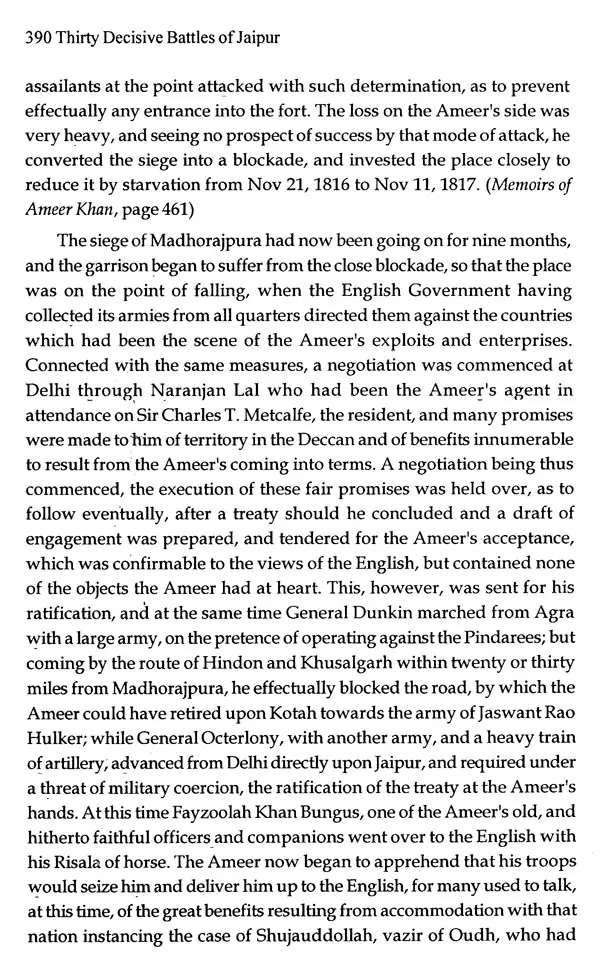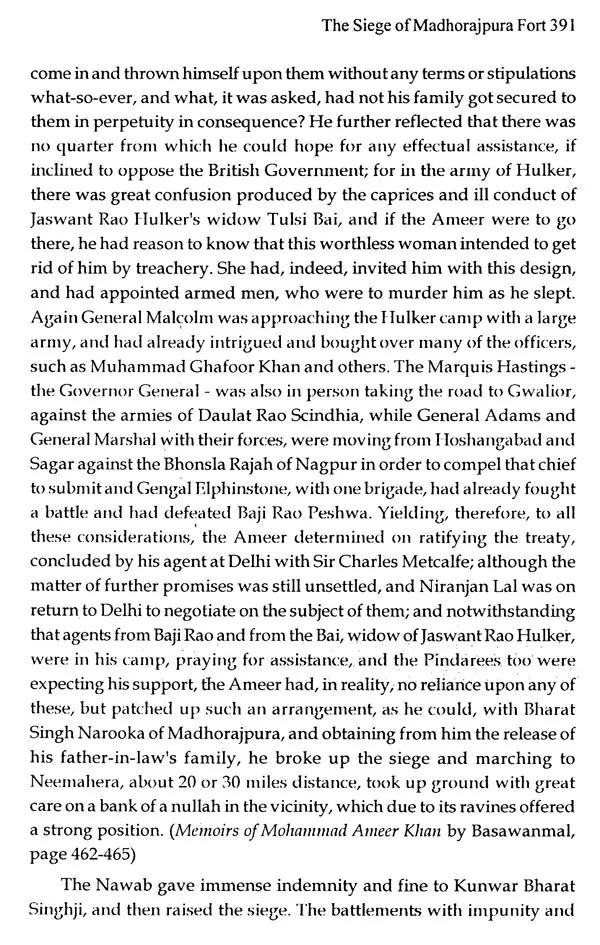
Thirty Decisive Battles of Jaipur
Book Specification
| Item Code: | UAH929 |
| Author: | Rao Bahadur Thakur Narendra Singh |
| Publisher: | Rajasthani Granthagar, Jodhpur |
| Language: | English |
| Edition: | 2022 |
| ISBN: | 9789391446086 |
| Pages: | 392 |
| Cover: | HARDCOVER |
| Other Details | 9.00 X 6.00 inch |
| Weight | 600 gm |
Book Description
The book, Thirty .Decisive Battle of Jaipur is a classic example of Rajput's Bravery and Sacrifice to' save their honor and homes. Author has not only covered the battles but have highlighted History of Jaipur.
A must read for every historian, and must read for every person who loves his country.
He entered Jaipur State Services in 1922.
He was appointed as Senior Member of Council of Jaipur State from 1925 to 1942. He was Education Minister for 17 years and Kiledar of Jaigarh Fort in 1943.
He was granted the title of Rao Bahadur in 1925, later elevated to the title of Rawal by the Maharaja of Jaipur. In 1957 he was elected to the Vidhan Sabha, and was the Deputy Leader of opposition.
His biggest achievement was the opening of first Agriculture College of Rajasthan in 1947. He wrote many books like: - "A Brief History of Jaipur:", "Thirty Decisive Battles of Jaipur", "A Biography of Maharaja Ishwari Singhji': "Veer Puja Satsai".
He married, firstly Ranawatji sa of Sanwad and secondly Jodhiji sa of Patodi. He adopted Kr. Ajit Singh who succeeded him. Rawal Ajit Singh was succeeded by Rawal Sangram Singh.
The above book gives us a descriptive account of the thirty famous battles fought by the rulers, their kinsmen and commanders both inside and outside the state. The learned author has given a true and correct account of some of the main battles fought by the Kachhwaha rulers against their enemies without any prejudice.
The Amber - Jaipur state produced some of very brave Kachhwaha rulers who were born generals like - Raja Bhagwant Das, Raja ManSingh Raja Madho Singh (Bhangarh), Mirja Raja Jai Singh, Raja Ram Singh-I and Maharaja Swai Jai Singh the found of Jaipur City and many of their kinsmen.
The Kachhwaha Rajput were great warriors, they fought many fierce battles and laid down their lives to protect the honor, dignity and freedom of the motherland.
The author has provided us with detailed account of the many important battles of the Jaipur state such as-The battle of Haldi Ghat, Subjugation of Shivaji war with Bijapur, Battle of Jwar Ki Garhi, Battle of Amber, Battle of Bagroo, Battle of Mangrol Bhatwara, battle of Kakor, Battle of Maonda-Mandholi, Battle of Malpura, Battle of Patan, Battle of Kalakankra Jaipur-Jodhpurware and some other battles.
This is a rare book of immense historical value and throws light on some of the very important events and their circumstances which are known and lesser known to us. In my opinion this book will be most valuable for scholars and readers of Rajasthan history.
History, we can safely assert, is incomplete in itself; the first mason lays down the foundation; the other erects the structure; the third polishes it and the last. gives it the finishing touch. I, on my part, belong to that school of thought in this subject, in which the first and foremost duty that rests upon the shoulders of a writer, who has already got some firsthand data or has some means to collect such from whatever material at his disposal, is to record them down for what they are worth and not to struggle fastidiously in search of more exhaustive facts for its thorough completion. By doing so he will, no doubt, be placing some material in the hands of the masons of the next generation, which will help them to erect the stately edifice, in their turn.
In other lines except martial spirit much more has been written by historians about the Jaipur State quiz: town planning, diplomacy, administration, culture and religion etc. I have tried, in this book, to narrate before the readers only the account of some of the battles fought by the Kachhwaha; and given a link in the chain which will help future writers to survey the whole historical problem. It is undoubtedly a stupendous and thankless task to pen the narrative of such a type where writing upon different battles separately one cannot help some repetition which naturally occurs in describing the context, causes and results of these battles. Great responsibility rests upon the shoulders of a History writer. I have tried my best to draw a true perspective of the picture and to place without prejudice the plain facts and circumstances before the readers. I hope the reader will excuse me for any drawbacks which might have occurred in doing so. There is always a thick crust over the mines of historical jewels of useless thought of ascendancy of one State or clan over another and, from the Bards to the Historians, few could be free from the tinge. The Rajpoot on the whole is very magnanimous from the times of yore and undoubtedly in dealing with the situation he had behaved in a generous spirit. There is only the need of using spikes and spades by the writers to dig those mines and we should refrain from seeking loopholes of one another, It is no doubt a disservice to the Rajpoot cause to find fault with one another and in not going to the circumstances and causes which came before them in difficult times.
By the kind commands of His Highness the Maharajah Sahib Bahadur, we prepared a list of the important battles fought by the Kachhwaha rulers and generals, and in doing sa the author made up in hue; mind to write about the heroic deeds performed by this state which are second to none in the history of India, nay of the world. It produced generations of chivalrous and brave Maharajas, who were born generals of the time. This gave him an impetus to write in detail and bow his head in loyalty to place the fruits of his labor a t his Master's lotus feet.
There are hundreds of ruling princes, thousands of Sardars, lacs of big and small landlords and zamindars and cores of Rajpoots in this community whose ancestors from times immemorial carved out the power and principalities. In the country and niche in the hearts of the enemy.
The Rajpoot is a best relative, a first class ruler, a most faithful servant and above all a chivalrous enemy. So many Amazonian ladies and Rajpoot warriors sacrificed their lives to save their honor and homes that still the slopes of the historical fortresses of India are gray with the ambers of the lotus flowers of Rawer and slippery with the bloodshed by the Rajpoots. Can any Indian have the audacity to forget their sense of sacrifice?
Book's Contents and Sample Pages
